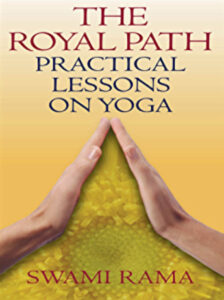
Nothing like a good book
I really enjoyed what Swami Rama had to say in The Royal Path, and I found that reading this book truly enhances my understanding of the meaning of Yoga, the multiple aspects of developing a practice, and why it’s called a practice. I found myself making side notes all the while reading, as this book is a deep and thought provoking, condensed read that left me wanting more information about Rama himself as well as his teachings.
I agree that “Yoga” is a generic term; one that has become tainted as a fad rather than a practice, as Rama explains right away in this read. I appreciate the identification, not only of what Yoga is, but he explains practice styles, or paths, as different ways of working toward the same goal. These various paths of Yoga each have a common goal of self-realization, and this book discusses Raja, or Royal, as a path that encompasses them all.
The chapter on the how and why of some important Asanas (postures or poses), is direct and an easy read with a detailed descriptions of the yoga postures, and some helpful photos, yet this is only a portion of what this book covers. Moreover the asana how to’s and benefits, I appreciate that Rama spends much more time on morality, breath, prana ( life force) energy, concentration, meditation, and the mind, as these are often not discussed in yoga classes and only briefly, if at all, mentioned in other the yoga books I’ve read.
The topic of religion is mentioned briefly in this book in relationship to Yoga and, again, I appreciate how Rama writes his contribution, as it seems to be a topic of controversy. He gives some resources to consider in the Bible, for those who would like reference of why he states yoga is sited in biblical history. My personal takeaway from this is simple; regardless of a person’s religious belief or practice, Yoga is complimentary as we all become better people through enlightenment. Yoga teaches us how to be, and religion teaches us what to do when seeking this enlightenment. “ Be still and know that I am God”; Psalm 46:10, is one of a few Bible verses I know by heart, and it is in alignment with stillness discussed throughout this book. I have experienced dialogue with people who question my pursuit to deepen my personal yoga practice related to concerns, interpretations, beliefs and ultimately fears and disbeliefs of how Yoga can possibly fit alongside or in harmony with religion. Perhaps people fear Yoga for not wanting to know themselves moreover not understanding the practice or knowing how to do poses.
Obviously, I found several compelling points in this required read for my yoga teacher training, as noted as my thoughts are intertwined with the book summary paragraphs above. I am drawn to learn more about how to incorporate Yoga into children, adolescent, and young adult sport programs, but moreover that, I am drawn to the possibilities of offering mediation and asana practices to women and children’s programs in my community. I am passionate about how sharing how yoga has brought me back to the self lost, maybe even left undiscovered, related to personal traumatic experiences. I am passionate about sharing yoga practice as a gift to manage frustrations and conflicts inevitable in life; a gift and available almost anywhere, at anytime. All points mentioned in this book.
This book simplified many thoughts I have had on yoga. I am inspired to share with others; a great reminder of what yoga has brought into my personal life and an easy read as almost an instructional handbook for someone new to yoga. Just decide. Just breathe. Be still. Become aware and open to releasing judgement of self, others, surroundings and circumstances. Just be.
The explanation that the asanas are not all Yoga is- is profound for me, as most Yoga, in current times and classes, is very form focused in power classes and high end boutique styles. This cultivation of a false and fad, yoga “community”, that I do not feel called to be a part of anymore. I am inspired to be more than a participant in a yoga community so far from what traditional yogic practices are.
I appreciate the clarity provided in The Royal Path; that Yoga is so much more than poses and sequencing. That Asanas ( poses) are to move the energy in, thorough, and out of our physical being~ that is prepared through involution, meditation, and concentration~ with still mind and awareness. All part of the path; a path that can produce freedom from imperfections and suffering with intentional practice.
In gratitude,
Nicole Muilenburg, RN-BAN, RYT-200

Recent Comments